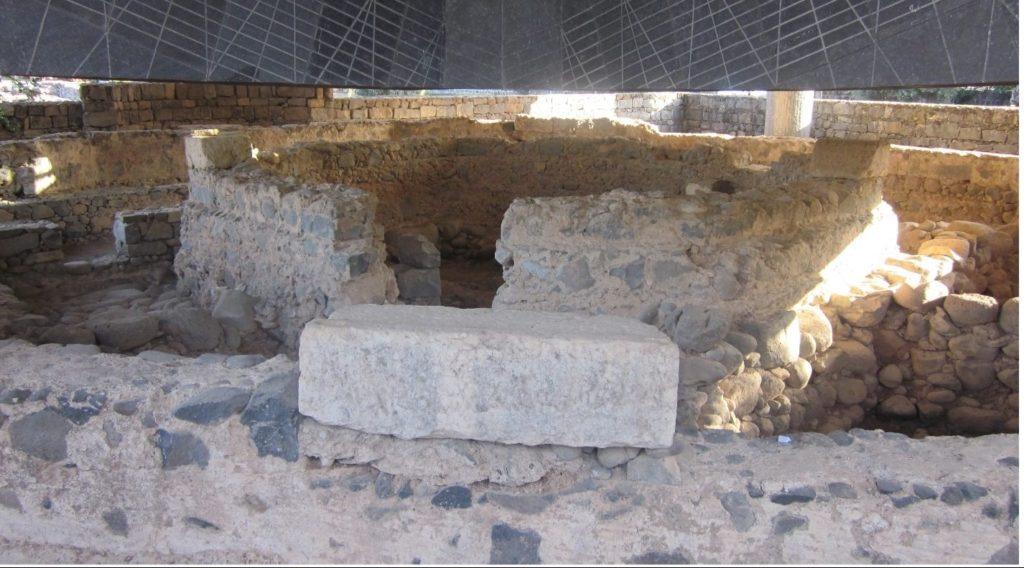29As soon as they left the synagogue, they entered the house of Simon and Andrew, with James and John. 30 Now Simon’s mother-in-law was in bed with a fever, and they told him about her at once. 31 He came and took her by the hand and lifted her up. Then the fever left her, and she began to serve them.
New Revised Standard Version Bible: Catholic Edition, copyright © 1989, 1993 the Division of Christian Education of the National Council of the Churches of Christ in the United States of America. Used by permission. All rights reserved.
32 That evening, at sunset, they brought to him all who were sick or possessed with demons. 33 And the whole city was gathered around the door. 34 And he cured many who were sick with various diseases, and cast out many demons; and he would not permit the demons to speak, because they knew him.
What to do with this educator’s commentary
This commentary invites you as a teacher to engage with and interpret the passage. Allow the text to speak first. The commentary suggests that you ask yourself various questions that will aid your interpretation. They will help you answer for yourself the question in the last words of the text: ‘what does this mean?’
This educator’s commentary is not a ‘finished package’. It is for your engagement with the text. You then go on to plan how you enable your students to work with the text.
Both you and your students are the agents of interpretation. The ‘Worlds of the Text’ offer a structure, a conversation between the worlds of the author and the setting of the text; the world of the text; and the world of reader. In your personal reflection and in your teaching all three worlds should be integrated as they rely on each other.
In your teaching you are encouraged to ask your students to engage with the text in a dialogical way, to explore and interpret it, to share their own interpretation and to listen to that of others before they engage with the way the text might relate to a topic or unit of work being studied.
Structure of the commentary:
See the general introduction to Mark
Text & textual features
Characters & setting
Ideas / phrases / concepts
Questions for the teacher
The world in front of the text
Questions for the teacher
Meaning for today / challenges
Church interpretations & usage
The World Behind the Text
See general introduction to Mark.
The world of the text
Text & textual features
This text has two distinct but connected parts: the healing of Simon’s mother-in-law and the healing of many who have sought Jesus out at Simon’s house.
Immediately prior to this text Jesus has called the first disciples – Simon, Andrew, James and John. He has then moved to the synagogue at Capernaum on the Sabbath to teach and heal – indeed, Mark 1:23-28 the exorcism of a man with an unclean spirit, is his first healing miracle.
As soon as they leave the synagogue, Jesus and the disciples enter the house of Simon and Andrew. Simon (Peter) is in his hometown, so the setting of this passage is his family home. The women, un-named (Simon’s mother-in-law), is the first woman encountered in the gospel of Mark. She is sick in bed with a fever and they tell him about her at once. Jesus goes to the woman, takes her by the hand and ‘lifts her up’. The fever leaves Simon’s mother-in-law and she begins to serve them.
That evening at sundown, when the Sabbath had ended, ‘the whole city’ gathered around the door of Simon and Andrew’s house. Their presence is answered somewhat by Mark’s mention (vs 28) that word of Jesus’ first healing spread around the countryside. In response the crowds bring others: those named as sick or possessed with demons. Jesus heals many, casting out demons whom he would not permit to speak.
The speed of the action in this passage and the one leading to it is typical of Mark, often referred to as a Gospel in a hurry. So too is Jesus’ actions in healing and exorcising freely. The faith of the recipient is not a necessary element here; the reign of God has just been announced, it is now underway!
Characters & Setting
Jesus
With the inclusion of the previous text of Jesus teaching and healing in the synagogue (Mark 1: 21-28), this ‘day’, a Sabbath, is seen as being a ‘snapshot’ of Jesus’ ministry as portrayed throughout the gospel of Mark. Jesus teaches, is identified as the ‘Holy One of God’ by a demon who he is casting out and Jesus rebukes him (messianic secret), cures the sick and in the morning (Mk 1:35) goes to pray in a deserted place.
Jesus’ touching of Simon’s mother-in-law is a recognition of her dignity. Symbolically, it indicates that Jesus considers Simon’s mother-in-law as part of his family/household.
Disciples
In Mark 1: 16-20, Jesus calls Simon and Andrew while walking along the Sea of Galilee. Further on, he encourages James and John to also follow him. On arrival at Capernaum, the group has become ‘they’. In Mark 1: 29-34 ‘they’ tell Jesus that Simon’s mother-in-law is ill with fever. These four disciples present an inner circle of the 12. They are often present with Jesus when other disciples are not (Mark 5: 37, 9:2, 13: 3). However, it is Simon’s mother-in-law who takes centre stage in the passage – it is she who demonstrates a key criteria for discipleship for Mark: service. As the Gospel proceeds while the 12 will fail to recognise this attribute as central to their mission, those disciples in the wider circle, will flourish. This woman begins a trend of un-named mostly women, who become true disciples of Jesus.
Simon’s mother-in-law
Simon’s mother-in-law is the first woman identified in the gospel of Mark. It is unusual that she is living with her son-in-law, this could indicate that she is a widow and has no male blood relatives to look after her. If so, she would have been very vulnerable in 1st century society, as someone without their own money. Her status then, as a ‘non-person’ contrasts dramatically with her actions of service, which place her in the centre of the disciples of Jesus.
The Hebrew word for widow connotes one who is silent or unable to speak. Without inheritance, widows became a symbol of the oppressed and vulnerable. Culturally, Simon would not have any responsibility to her but has taken her into his home. Theologically in the gospel of Mark, disease is a mark of the presence of evil or ‘dis-ease’. Jesus’s liberation of this woman means she is free to become a disciple of the Christ she serves.
Demons
Jesus in the gospel of Mark is a prolific exorcist. Today we might consider those in the gospels possessed by demons to be suffering from a mental illness. The writer of Mark’s gospel sometimes indicates that these people have an ‘unclean spirit’ (Mark 1: 23) which translates to something that is opposed to the ‘holy’. Those with demons are lacking in wholeness or out of order, thy are not flourishing. The demons respond to Jesus’ action as he is stronger, he has been identified by the demon in the previous text (Mark 1: 2-28) as the Holy One of God.
The house of Simon and Andrew
The gospel of Mark has a focus on Peter (Simon) and on households. With the calling of the disciples (Mark 1:16-20) Jesus begins to form a family around him, those that follow him and who are learning to be disciples. It is believed that the original audience for the gospel of Mark were in Rome. Their expression of ‘Church’ was probably households with based around a patriarch plus extended family, slaves, freedmen, and other clients. In this text, the house of Simon becomes a gathering and healing place centred around Jesus. It becomes a ‘church’. The ruins of what is believed to be Simon Peter’s house are still at Capernaum.
Capernaum–
Capernaum is on the northwest side of the Sea of Galilee. In the gospels it is the centre of Jesus’ Galilean ministry, a small fishing and agricultural village. Mark describes it as a ‘city’ (Mark 1: 33) although it was in fact a modest village. Archaeologists have discovered the remains of a 4th century synagogue believed to be built on the foundations of an earlier synagogue. Between the synagogue and the lake shore the remains of a multi-roomed house has been discovered. There is evidence that the ‘house’ has been used as a large communal meeting place. Also on the site are the remains of a 4th century renovation to enhance a large meeting room and a 5th century octagonal Church. The site is known as ‘Peter’s (Simon’s) House’. A 20th century church has been built on stilts above the excavation site.


Ideas/phrases/concepts
Sickness
Fever at the time of the writing of the gospels was an illness that was dangerous or life threatening. Simon’s mother-in-law was seriously ill before her male family members intercede for her with Jesus. This makes her immediate recovery even more miraculous. The woman experiences a return to full life through Jesus.
Lifted her up
The writer of Mark uses the same language to describe the healing of Jairus’ daughter (Mark 5:41) and of the tormented boy (Mark 9:27) It is also the same Greek word that is used for Jesus’ resurrection (Mark 16:6). Simon’s mother-in-law is a symbol of all who are raised by Jesus to new life.
Serve
In the original Greek the word used here is ‘diakonein’, the root of the word ‘deacon’. After her healing, Simon’s mother-in-law follows and ministers as a faithful disciple. The life of the disciple is to serve. The writer of Mark uses the same word in Mark 10:45 when Jesus says that he has come not to be served but to serve. In his choice of this word to describe the woman, Mark highlights her actions as those of a disciple: she stands as one of many who, outside the circle of the 12, are too often ‘invisible disciples’ ignored in favour of the failing 12.
The whole city was gathered near the door- Some older translations use the phrase ‘the whole world was pressing against the door’. Simon’s house becomes a place of healing and forgiveness. It is a model for the household churches of Mark’s community.
Healing on the sabbath
The healing of Simon’s mother-in-law occurs on the Sabbath. The reign of God is present in the healing of the woman. Jesus would soon be challenged (Mark 2: 23-28) about his lack of respect for the Sabbath. At sunset, when the restrictions of the Sabbath are over, the crowd gathers around the door for healing.
Questions for the teacher:
The world in front of the text
Questions for the teacher:
Please reflect on these questions before reading this section and then use the material below to enrich your responsiveness to the text.
Meaning for today/challenges
The focus of this text is found in its placement at the very start of the ministry of Jesus. These passages evidence the divine power of Jesus, visible in his healing and casting out of demons. Jesus engages with people readily and compassionately. In doing so he breaks a cycle of illness, that lead to poverty, injustice and oppression.
The disciple today is challenged to learn from Jesus and break cycles of oppression, providing healing where they can to those around them. Simon’s mother-in-law is ‘lifted up’ to a fullness of life that involves service to others. She demonstrates her faith by her service, her faith is not a prerequisite for her healing or her interaction with Jesus. It is her service that signifies her as a member of his community: a disciple. The need for the Church to reach out in service to others regardless of who they are or their faith is central to the story.
The use of the word ‘diakonein’ for the service that Simon’s mother-in-law provides, one of ministering to others, brings into question the role of women in the Church today. The woman serves the household/church of Mark’s community centred around Jesus. The same word that is used for her service that Jesus uses for his own. This text could be seen as supportive of the diaconate for women or for a stronger presence in Church leadership.
Church interpretation
The Sacrament of the Anointing of the Sick makes present Christ’s healing presence. The sacrament involves healing touch as Jesus demonstrates in this text, prayer for spiritual and physical healing and comfort for those who are suffering from illness and those who love them. There are parallels to this text from the gospel of Mark.
This text and those immediately before and after give a day in the life of Jesus. This provides a framework for what it means to be a disciple- teaching, healing others and taking time for prayer.
Liturgical Usage
This text is used on the 5th Sunday of Ordinary Time, Year B. This generally falls just before the season of Lent when followers are challenged to be better disciples.
